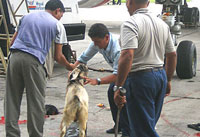Dashain Celebration In View Sense
I did not buy a goat today because the price has suddenly gone up. Until yesterday the cost of a live goat was Rs. 220 a kg, but today it is Rs. 250 a kg," Niroj, a local butcher said. Currently, Niroj is selling a kilo of goat meat at Rs. 420, and he expects the price to increase to more than Rs. 500 during Dashain. A week ago he used to sell the same meat at Rs. 480. The cost of chicken, too, has dramatically gone up in the recent weeks. Until two weeks ago, one was buying a kg of chicken at Rs. 170, but this week it is Rs. 220 per kg.
Going by the escalating prices of the meat items in the local market, the city dwellers are surely going to have an expensive Dashain this time.
Also there might be an acute shortage of goat meat in the local market this time. The consumers have already seen the signs. As a large number of people from the eastern and western development regions who live in Kathmandu are unable to return home for the festival following the floods, the demands for meat in Kathmandu will surely go up. The Koshi floods have damaged the roads in the east, and the recent calamity caused extensive damages in the western region, preventing many from going home. As a result, the capital city will have many more mouths to feed this time.
According to a news report, last year there was a demand for 15,000 goats in Kathmandu, and officials at Nepal Food Corporation say this year there will be a demand for 20,000. However, the claims of the officials do not look relevant considering the high population of the valley and the heavy consumption of meat especially during the festival season. Almost every household wants to buy a goat for Dashain.
Until a few years ago, the government used to import sheep from the Tibet Autonomous Region (TAR) of China to meet the demand for meat during Dashain time. But of late, the practice has been discontinued. Instead, traders supply goats and sheep to the Kathmandu Valley from the villages bordering the TAR.
Besides the goats reared domestically, Indian goats are being supplied to the capital from the Kapilvastu entry point. The local traders buy goats from the Indian villages and collect them at Kapilvastu in western Terai before supplying them to Kathmandu and other cities. Besides goats, the people also consume buff, pork, fish and chicken.
It is indeed a big irony that an agricultural country like Nepal has to import not only food and fruits but also animals for meat from neighbouring countries. And still the people must face food shortages.




